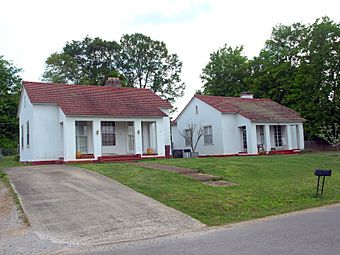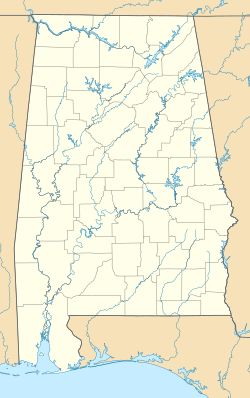Village Number 1, Alabama facts for kids
Quick facts for kids |
|
|
Nitrate Village No. 1 Historic District
|
|

Houses on Norris Circle in April 2017
|
|
| Location | Roughly bounded by Wilson Dam Circle, Wheeler and Wilson Dam Aves., Fontana, and Pickwick Sts., Sheffield, Alabama |
|---|---|
| Area | 75 acres (30 ha) |
| Architect | Harold A. Caparn |
| Architectural style | American Craftsman, Mission Revival |
| NRHP reference No. | 84000603 |
| Added to NRHP | August 30, 1984 |
Village Number 1, also known as The Village, is a special historic place in Colbert County, Alabama, United States. It was originally built as a community for workers at a large factory.
Contents
History of Village Number 1
Building the Nitrate Plants
In 1916, during World War I, President Woodrow Wilson signed a law called the National Defense Act. This law allowed the government to build factories that would make special chemicals called nitrates. Nitrates were important for making explosives needed in the war. The law also said a big dam should be built to provide electricity for these factories.
President Wilson chose a place called Muscle Shoals, Alabama for the dam. This dam, finished in 1924, was named Wilson Dam. It would power the new factories. The first factory was planned to make ammonium nitrate using a method called the Haber process. But soon, they realized this method wouldn't make enough. So, another factory was built using a different method called the cyanamide process.
Designing the Village
To house the people working at Nitrate Plant No. 1, a special village was planned. A famous architect from New York City, Harold Caparn, was chosen to design it. He had also helped design the beautiful Brooklyn Botanic Garden.
Construction of the village started in late 1918. It was designed to look like a handbell from above! The houses were built around the 'handle,' 'body,' and 'clapper' parts of the bell shape. A school was placed at the bottom. When it was finished, the village had 112 homes, two school buildings, and a large apartment building for single officers. Maud Lindsay, a well-known writer of children's books, became the first kindergarten teacher at the school.
The Village After the War
World War I ended on November 11, 1918. With the war over, the factories were no longer needed to make nitrates for explosives. So, the plant closed, and the newly built houses in the village stood empty.
In 1921, Henry Ford, who created the Ford Motor Company, offered to buy the factories and the village. He wanted to turn them into a big industrial area. However, for many years, only a few houses were lived in, mostly by workers from the Alabama Power Company.
Senator George W. Norris believed the site should be used for the public good. In May 1933, President Franklin D. Roosevelt created the Tennessee Valley Authority (TVA). The TVA was a government agency that would use the industrial complex to make fertilizer and help the area develop.
In 1949, the TVA gave the streets, playgrounds, and school in the village to the city of Sheffield. The houses were then sold to the public in an auction. Today, Village Number 1 is a historic district, recognized for its unique design and important past.
See also
 In Spanish: Village Number 1 para niños
In Spanish: Village Number 1 para niños



